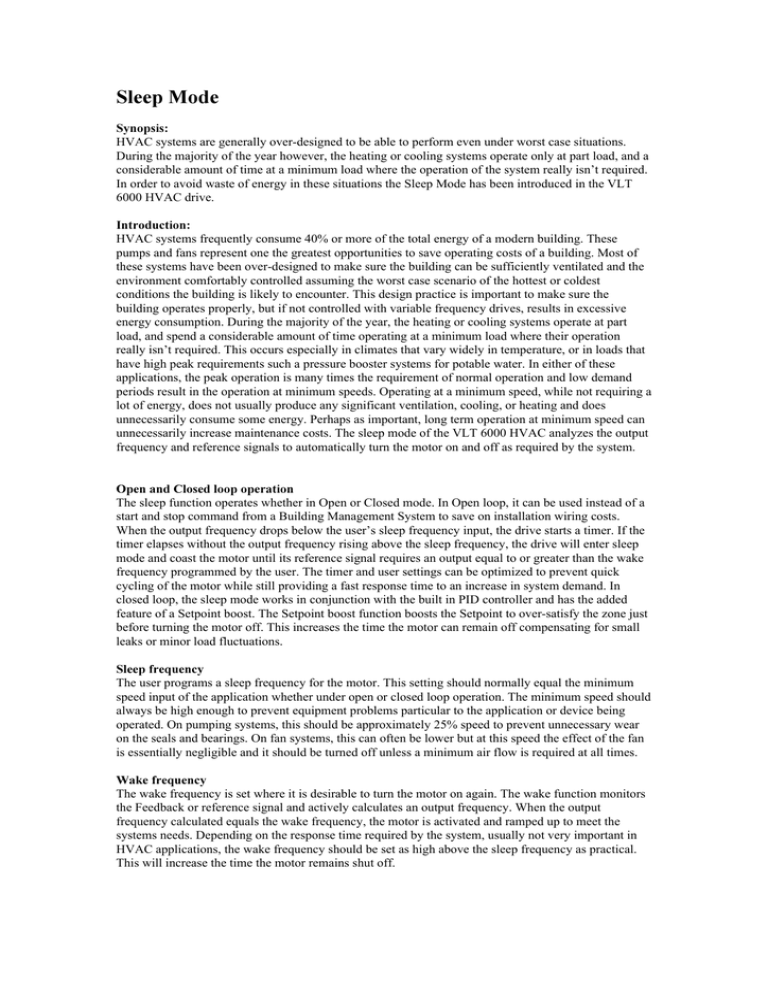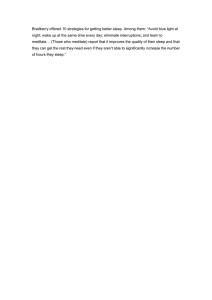Sleep Mode
advertisement

6OHHS0RGH 6\QRSVLV HVAC systems are generally over-designed to be able to perform even under worst case situations. During the majority of the year however, the heating or cooling systems operate only at part load, and a considerable amount of time at a minimum load where the operation of the system really isn’t required. In order to avoid waste of energy in these situations the Sleep Mode has been introduced in the VLT 6000 HVAC drive. ,QWURGXFWLRQ HVAC systems frequently consume 40% or more of the total energy of a modern building. These pumps and fans represent one the greatest opportunities to save operating costs of a building. Most of these systems have been over-designed to make sure the building can be sufficiently ventilated and the environment comfortably controlled assuming the worst case scenario of the hottest or coldest conditions the building is likely to encounter. This design practice is important to make sure the building operates properly, but if not controlled with variable frequency drives, results in excessive energy consumption. During the majority of the year, the heating or cooling systems operate at part load, and spend a considerable amount of time operating at a minimum load where their operation really isn’t required. This occurs especially in climates that vary widely in temperature, or in loads that have high peak requirements such a pressure booster systems for potable water. In either of these applications, the peak operation is many times the requirement of normal operation and low demand periods result in the operation at minimum speeds. Operating at a minimum speed, while not requiring a lot of energy, does not usually produce any significant ventilation, cooling, or heating and does unnecessarily consume some energy. Perhaps as important, long term operation at minimum speed can unnecessarily increase maintenance costs. The sleep mode of the VLT 6000 HVAC analyzes the output frequency and reference signals to automatically turn the motor on and off as required by the system. 2SHQDQG&ORVHGORRSRSHUDWLRQ The sleep function operates whether in Open or Closed mode. In Open loop, it can be used instead of a start and stop command from a Building Management System to save on installation wiring costs. When the output frequency drops below the user’s sleep frequency input, the drive starts a timer. If the timer elapses without the output frequency rising above the sleep frequency, the drive will enter sleep mode and coast the motor until its reference signal requires an output equal to or greater than the wake frequency programmed by the user. The timer and user settings can be optimized to prevent quick cycling of the motor while still providing a fast response time to an increase in system demand. In closed loop, the sleep mode works in conjunction with the built in PID controller and has the added feature of a Setpoint boost. The Setpoint boost function boosts the Setpoint to over-satisfy the zone just before turning the motor off. This increases the time the motor can remain off compensating for small leaks or minor load fluctuations. 6OHHSIUHTXHQF\ The user programs a sleep frequency for the motor. This setting should normally equal the minimum speed input of the application whether under open or closed loop operation. The minimum speed should always be high enough to prevent equipment problems particular to the application or device being operated. On pumping systems, this should be approximately 25% speed to prevent unnecessary wear on the seals and bearings. On fan systems, this can often be lower but at this speed the effect of the fan is essentially negligible and it should be turned off unless a minimum air flow is required at all times. :DNHIUHTXHQF\ The wake frequency is set where it is desirable to turn the motor on again. The wake function monitors the Feedback or reference signal and actively calculates an output frequency. When the output frequency calculated equals the wake frequency, the motor is activated and ramped up to meet the systems needs. Depending on the response time required by the system, usually not very important in HVAC applications, the wake frequency should be set as high above the sleep frequency as practical. This will increase the time the motor remains shut off. 6HWSRLQWERRVW Under closed loop operation, the Setpoint boost function operates to prevent short cycling of the fan or pump. In some systems, especially pressure boosting pump applications, turning the pump off results in a small pressure loss in the system. If this loss causes the feedback signal to drop below the Setpoint, the PID controller can quickly increase the calculated output speed to levels above the wake frequency causing the system to quickly cycle on and off. The Setpoint boost function increases the Setpoint by a user determined percentage to temporarily over-satisfy the load. Once the higher Setpoint is reached, the motor is turned off and the original Setpoint is restored. This causes the PID controller to realize the systems requirements have been met and the motor isn’t re-activated until required. 7LPHU In order to prevent turning the motor off prematurely or on a temporary load fluctuation, a timer exists to delay the drive from entering sleep mode. Once the output frequency drops to a level equal to or below the sleep frequency, the timer is started. If the timer elapses without the output frequency exceeding the sleep frequency, the drive enters sleep mode and either turns the motor off, as in Open loop operation, or enters Setpoint boost mode as in Closed loop operation. If the output frequency exceeds the sleep frequency, the timer is reset. The timer is user set between 0 and 300 seconds.


